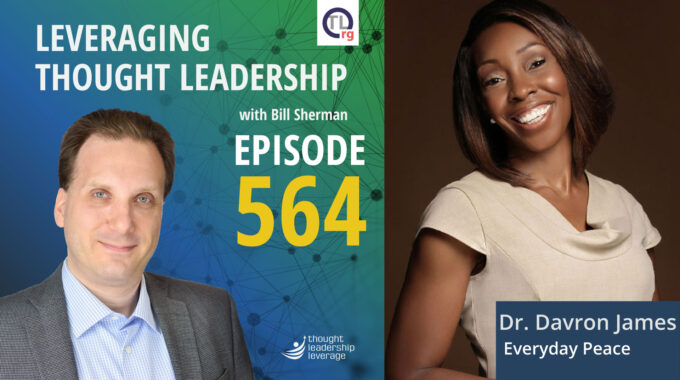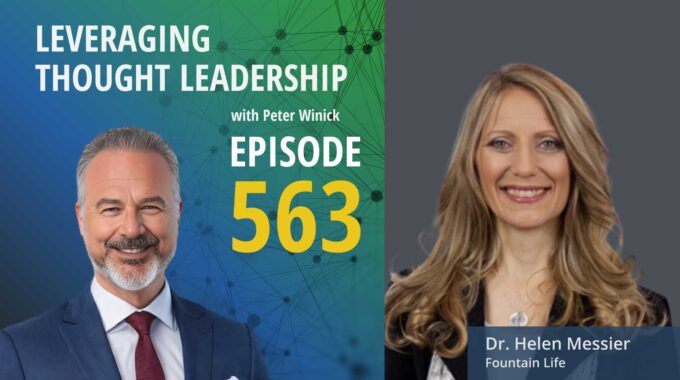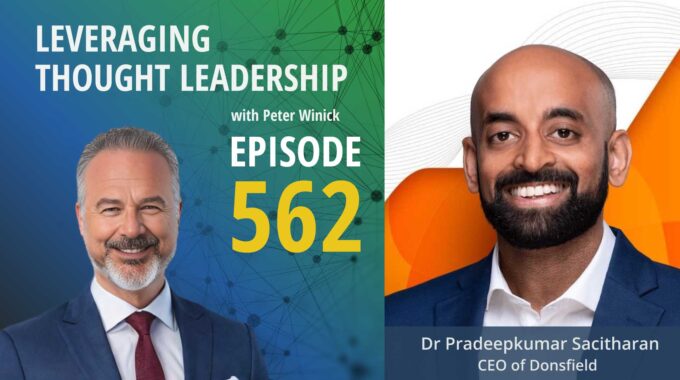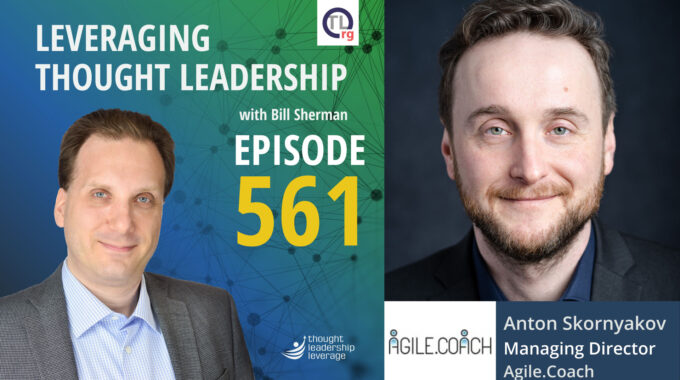Embracing Self-Awareness for Personal Growth and Peace A conversation with Dr. Davron James about her…
The Breakthrough Manifesto | Kim Christfort
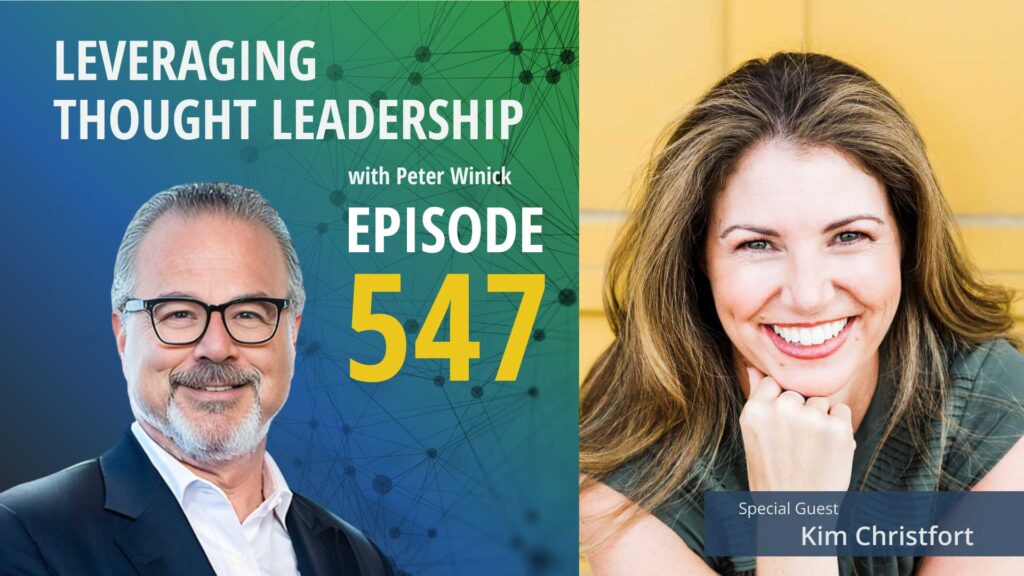
Using immersive experiences to achieve breakthroughs.
An interview with Kim Christfort about sparking transformative innovation.
Organizations often talk about having a culture of innovation.
But what does that look like?
To explore innovation and how to achieve transformative breakthroughs I’ve invited Kim Christfort to join me. Kim is the Chief Innovation Leader and National Managing Director of Deloitte Greenhouse Experience, where they work to spark new thinking, accelerate decision-making, and build long-term business development.
Kim shares how her background in theatre and science gave her a love for problem-solving and interacting with people, but it wasn’t until she created her position at Deloitte for herself that she could fully incorporate her creative side.
The Deloitte Greenhouse Experience is not just a space, it is an experience, a stage where Kim can set the environment to diagnose what is holding the group back and activate the brain through immersion to create momentum and opportunity to break through the barriers that are holding you back.
For ten years Kim and her team have been working with people, teams, and leaders to achieve breakthroughs but have never codified or packaged the research and data they have been doing. This was the catalyst for Kim’s book The Breakthrough Manifesto which acts as a field guide for leaders and organizations to act, join the movement, and achieve breakthroughs that can fundamentally shift the way an organization thinks and operates.
Three Key Takeaways:
- A good metric for thought leadership is repeat usage. If people continue to come back time and again, investing their time and money they must be seeing value from it.
- Moments are all around us. They are opportunities. Thought leadership can have a huge role in making those opportunities visible to clients.
- Thought leadership that can become a movement is powerful. Those who believe in your ideas will become your biggest and loudest champions.
If you need a strategy to bring your thought leadership to market, Thought Leadership Leverage can assist you! Contact us for more information. In addition, we can help you implement marketing, research, and sales. Let us help you so you can devote yourself to what you do best.

Transcript
Peter Winick And welcome, welcome, welcome. This is Peter Winick. I’m the founder and CEO and thought leadership leverage. And you’re joining us on the podcast today which is leveraging thought leadership. Today my guest is Kim Christopher. She’s chief innovation leader and national managing director at Deloitte Greenhouse Experience. She’s an author, a strategist, an experience designer and an innovation speaker. She’s got a book out called The Breakthrough Manifesto ten Principles to Spark Transformative Innovation. And, uh, we get to chat with her for a bit today. So welcome, Kim.
Kim Christfort Thank you so much. I’m delighted to be here.
Peter Winick Thanks. So let me ask you this. So what’s your journey? What’s your path been? Right. Because I don’t think anybody x number of years ago when they were starting careers said, uh, I want to be a thought leader. I want to be run innovation at Deloitte. So how did how did this all happen?
Kim Christfort It’s funny you say that because I think the story sounds better in reverse than it did from the start. I would not have guessed I would, I would be here. I actually come from a background of theater and science. Uh, so I was a pre-med undergrad, but I did a ton of performing arts and one like.
Peter Winick Oh my, the science guy.
Kim Christfort I don’t think I can be as cool as Bill Nye the Science guy, but, uh, I definitely have experience in that direction. Maybe, like, maybe we’ll keep trying.
Peter Winick I’ll send you a bow tie. Yeah.
Kim Christfort Haha. Yeah. So it was interesting because I, I was sort of on this path of doing something in medicine. I love problem solving. I loved interacting with people, uh, and really being helpful in that way. But I was missing this ability to tap into my creative side as well. And, you know, when I landed at Deloitte, it was really more because I realized medicine probably wasn’t the best route for me in terms of, of some of my interests. And so, I was going down the problem-solving path and still didn’t have the creativity side. And so over time, I kept looking for opportunities to weave in the different things. And really, my current job was created by me. For me, uh, you know, with a lot of people who help bring it to life, but it was meant to be a synthesis not only of my passions, but of people’s brains. You know, we are all very intellectual people in the business world, but we also have creative, human emotional sides, too. And so it was a way to bring those things together.
Peter Winick So stay there for a minute, because I don’t think it’s as unusual, at least in my world, as you think it is, that many of the people that I work with that I speak with, that we support their job. If they have a day job was created for them. It wasn’t like they were the 11th person to be the, you know, SVP of refrigerated supply chain. I think I think that’s actually sort of in an uncommon way, common, particularly in professional services. Like somebody the spark goes off, they have an interest, they’re passionate. They happen to be a good speaker or a good writer or whatever, whatever, and the firm or whatever finds places for them. Then you’re like, oh, but we have to give them a job and a title and what it like, do they have direct reports? And probably a budget would be lovely. And like, I think a lot of people have, you know, creativity applies to the role that you’ve actually created. So that’s pretty cool.
Kim Christfort Yeah. No, I think that’s very true. And I think part of it was, you know, in the early parts of my career, people were definitely trying to figure out, you know, how do we how do we leverage our a different ways and how do we sort of, as you say, create something that that would bring that to life. And then as I advanced in my career, then it was me saying, I know you asked me to do this, but what I actually should do is this other thing which will give you everything you want and more. And that’s really what the greenhouse was. My greenhouse originally was a space strategy. It was an idea of having a space to bring people together. And do you know, whatever it is they wanted to do, it could have been learning and development. It could have been innovation. And when they brought me in delete it, it was an operational role. And I said, yeah, about that. Here’s what I think it could be. And so we’ve turned it into a engine really for innovation and transformation much more broadly versus just managing real estate, when.
Peter Winick It used to be because I was visiting one of them and, um, I think it was Chicago years ago, but it used to be almost the showroom of or a physical come to this place and will blow your mind kind of thing. Then this little thing called Covid happened. So that kind of didn’t work right. Like, like, so I like what you said. It’s more like an engine or, uh, it’s a place. That’s not a place.
Kim Christfort Right, exactly. I mean, what we found and luckily we discovered this pre-COVID, uh, even because what we found is it’s not about the space. It’s about the experience and the. Yeah, the space is a petri dish for us. You know, it lets us. Or maybe a more pleasant term since we’re talking about canvas. Uh, all right, Covid, let’s go away from my petri dishes. But, uh, you know, more pleasant term, is it? It’s our stage, you know, that’s where we’re able to set the environment. But what we’re really doing is diagnosing what is holding this group back. How do we then create an experience in this space? Potentially. But even outside of it, you know, Covid was a great example. Of creating experiences without physical space and that activation of the brain. Through immersion, whether that’s actual literal immersion or whether that’s doing things through. Through a virtual setting is is what we found to be the key.
Peter Winick So how whether it’s deployed, or you can talk more generally, how are decisions made around metrics and give this more and give this. So there’s yeah there. Right. So there’s certain parts of businesses it’s easy to say kill this, feed this, try this. Like what are you measured against. What are the KPIs against. Because they’re making significant investments in terms of the book and your time and then the people. Oh yeah. Oh yeah.
Kim Christfort Oh impact and getting huge value back I feel compelled to add. But yes, I laugh at the metrics question because I think people, especially in Deloitte, where we have a strong accounting practice, they like to count things, you know, can we go here? And what we’re talking about, experience is what I don’t want. So the metric I avoid is how many sessions have you done. Right. Because volume is not ROI. And so yes.
Peter Winick For a minute because so funny because I’ve seen this time and time again where it’s, you know, you don’t measure thought leadership by the pound. So more is not necessarily better than less. Right. So you know, if you put out one piece a week two would be double. So why don’t we get you to do three and like, you know ultimately.
Kim Christfort Exactly.
Peter Winick Yeah. Yeah.
Kim Christfort No I think you’re so I think you’re so right. Because volume tends to be our sort of easy metric across the board, whether it’s thought leadership or the kinds of things that we do.
Peter Winick Or how many months. Right.
Kim Christfort Like how many widgets. Exactly. Exactly. Right. But, you know, I mean, even with other spaces, if I even put the sort of thought leadership and experience piece to the site, even other spaces aren’t always measured on utilization. You know, you think of a stadium or an amazing theater. You know, it’s about that incredible moment. It’s not solely about keeping it busy all the time. So I don’t like that metric, the metric that is actually an interesting one that I think, uh, has served us quite well is repeat usage. So if we have people coming back again and again and again and willing to invest their time and money to use us, they must be seeing value out of it. I like that one because it’s wait.
Peter Winick So repeat usage meaning ongoing engagements.
Kim Christfort Well, not even of sold projects necessarily. So the way the way we exist, we exist to really spark new thinking, to accelerate decision making, to do a lot of things that may not have an immediate payoff there. It’s sort of longer-term business development, uh, kinds of things. And so if the people within Deloitte or their clients say, wow, that session was so helpful or that conversation was so useful, I want to come back in. Great, because that I, you know, that has a back-end assumption built into it, which says they used it for something that gave them enormous value. Now, I also try to measure the long-term value, you know, was a client able to actually transform their organization or was our account team able to deepen their relationships. So we do look at things like that. But I think that indirect method of looking at usage is actually one that’s overlooked sometimes in a really.
Peter Winick Because it’s easy to deal with the lazy vanity metrics of, oh, how many downloads? And it’s like, okay, so if you got X number of downloads on this piece, well, who’s downloading it? If it’s a bunch of undergrads in Iowa? Well, that’s not the business. Right. And I think people don’t. It’s just such an easy way to look at oh this got more than that. Therefore, it’s better. And it’s really the composition of as opposed to the quantity of when it comes to those things. Because certain pieces that you’re producing from a leadership perspective, the universe of who is really relevant and important to might be fairly small, like hundreds, maybe the total universe. So if you got 30 people looking at it like as a percentage, that could be phenomenal versus yeah, for sure.
Kim Christfort Yeah for sure. And I think we, you know, I’m probably making my life harder on myself than I need to by insisting on these other metrics. I mean, I could absolutely get my, my volume metrics up, as you say, by silliness. You know, I bring people in for random things or get random downloads. But I think that, you know, we really believe that there’s a ripple effect to all of this. Yeah. And so if I reach the right people in the right time, in a moment that matters to them and this concept of moments that matter, that’s a big concept we use all the time. If I reach somebody in a moment that matters, that’s going to have impact not only on them, but on their teams, on their organizations and hopefully eventually the broader world.
Peter Winick If you’re enjoying this episode of Leveraging Thought Leadership, please make sure to subscribe. If you’d like to help spread the word about our podcast, please leave a five-star review at ratethispodcast.com/ltl and share it with your friends. We’re available on Apple Podcasts and on all major listening apps as well as at ThoughtLeadershipLeverage.com/podcast.
Peter Winick So stay with that moments that matter. Because what I think is when you’re in professional services we always have the supply. Theoretically the demand is questionable as to at a moment in time, whatever the professional services you are now was then you go from being. I was completely irrelevant to them yesterday to I’m the most relevant thing in the world today based on an event or meeting or whatever, whatever. So I love these moments that matter because a you consistently have to get stuff out in front of people to keep the awareness going on, and then eventually it’s you get it’s out of your control, that moment that matters typically. Right?
Kim Christfort That’s exactly right. And this idea of thinking about things in terms of modes of matter was actually the work of my former colleague and mentor, Brian Future. But what he said is moments are all around us. There are opportunities and some moments are very obvious and they’re coming to you. So, for instance, one of the ones we talk about quite a bit is a client in transition. I either got promoted to a new job or maybe I’m switching. Organizations like that is a moment that matters to that person, but it’s there. It’s in front of you, you can see it and do something about it, and that can lead to all sorts of other things. But the other kind of moment that I think is as interesting and often overlooked is moments you make. So you don’t necessarily have that transition happening. And to your point, you know, maybe there’s attention elsewhere and they’re not focused on you and you’re the last thing on their to do list, you know, how do I make a moment? And I think thought leadership has a huge role to play in making moments, if it’s really tailored to that person. So you may be the last thing on their list, but you happen to know that something’s happening in their industry or there was an interesting announcement, and you relate what you’ve done in thought leadership to that thing, proactively providing it with no expectation of anything in return. It’s simply a hey, you know, thought of, you thought this might be relevant. Here’s the reasons. And by the way, that could be my own thought leadership. Or it could be somebody else’s. You know, you’re just like.
Peter Winick I think people often don’t understand the power of relationship development and such vis-a-vis thought leadership. Because if I if you’re kind of on my radar, as you, maybe you could be a client at some point in time, right. Well, I can give I can do the quarterly is now a good time for us to chat email that nobody wants or in an unpredictable way, from a time standpoint, send you stuff that’s really insightful, whether it’s something I created or something. Hey, read this piece based on our last call. I know you’re struggling with that. Thought this would be cool. Whatever. That’s a way to stay top of mind. And even when you’re creating thought leadership like a book, like an article, say, can we grab a couple minutes to talk about this? Because I know you have a perspective and I’m doing a series on this or a book or whitepaper, whatever it is, that’s a call people will often take versus, can we do the check in where I try to sell you some stuff and you try to avoid being sold because that’s.
Kim Christfort That’s exactly that’s exactly right. And it’s Goldilocks principle. Right. Like, you know what? Too much. You don’t want too little. You want just right. And just right may not only be quantity, it may also be it is personalized to whatever they are trying to do in that moment. And so I had an example of this earlier today. I was talking about the new book, The Breakthrough Manifesto, with someone, and we wanted to do an event and the person was like, oh, okay, a book event, a fireside chat, like, fine. I said, actually, here’s what I was thinking. It’s actually not a fireside chat about the book. It’s a fireside chat about the issues that people are facing in this particular industry, and how the book can actually help to accelerate pipeline, because I knew that that audience was really about right about me, not about the book.
Peter Winick Yeah, yeah. No, I love that. Because oftentimes, you know, authors do that say, hey, you know, I’m in book mode and the client’s like, well, I don’t care what mode you’re in. Like what? What’s in it? How does this relate to me? But if you say the principles in the book, when applied to this population could give you this benefit.
Kim Christfort Which so what part?
Peter Winick Which is a good segue into the book. Nice plug, by the way. Um, so give me a just the high-level overview of how the decisions made and then why you decide to write a book and then what the expectation is, because I think there’s a lot of fuzziness around that many places or with many. Yeah.
Kim Christfort Yeah. So this book really came about because for more than a decade, our group had been doing work to get people, their teams, the leaders to breakthrough. And this concept of breakthrough we found to be really interesting that the different take on innovation, it’s saying, you know, whether you’re inventing some amazing new phenomenon or you’re just transforming your organization in some way, it often requires breaking away or breaking down whatever it was holding you back, getting out of that status quo and moving through, making momentum to something different. And so for. Ten years we’ve been doing this, but all of the research that we’d been gathering and that we’d been utilizing from outside had never really been codified and had never been packaged up in a way that we could talk about it. And that’s why it’s called a manifesto. We realized, you know, part of this is about being very transparent and really owning our beliefs in a visible public way. And that has several benefits, you know, that lets us be consistent as an organization with how we’re doing this, but it also lets other people say, oh, that idea of making a mess or not playing nice like, that’s intriguing. Let me do more. And so as we started packaging this up into principles, we got a lot of interest from our clients because we said, yeah, this is the way we do things. And they said, that’s great, we’d like to do that too. And the book was really a response to that. It was a way for us to take that and put it out in the world. Now, one thing that we did differently about this book was we did it in two halves. So the first half is talking about the ten principles themselves. The second half is actual method. So we said, if we’re going to put this out in the world, we don’t want people to buy it and put it on a shelf. Although buying it is always nice, but we want them to actually use it more like a feel guide if you will like, actually take it off the shelf, flip through and do something different.
Peter Winick I love that, and you know, implied in a manifesto often is it’s a movement, right? So people lean in to manifestos because it speaks to them. They’re like, oh my God, this, this is like, this is the thing, right? You go back to some of the, you know, the checklist manifesto or Agile manifesto or uh, whatever they take on like, uh, almost a cult like craziness to them in a good way. Like once somebody sort of becomes a raving fan of the manifesto of like, oh, would they give it to the people that they know? You got to check this out, right? Like they become your best advocate and best fan. I’m a big fan of manifestos. I think when you design them well and deploy them well and use them to increase awareness, engage folks, and then ultimately get them to some sort of a call to action. It’s pretty cool. There’s a secret handshake part of it.
Kim Christfort It’s okay. I’ll have to show you that later. Yes. It’s.
Peter Winick Yeah, yeah, yeah.
Kim Christfort No, I love your description of it as a movement. And I think that’s so critical to what we’re talking about, because this book is not about point in time innovation and transformation. It’s really about the broader journey. And the journey requires bringing people along and getting them to lean in, as you are describing. And so having a manifesto that is able to help drive that movement and drive that momentum and drive that enthusiasm is critical because innovation’s tough transformation is tough, and you need to have a sustained effort to get there, and you need to have other people along on the journey.
Peter Winick It’s usually some outliers inside of an org trying to convince others to do it. So when they find their tribe, when they find their peeps like, wow, everybody here is kind of crazy like me. And they get it right. Like so I think there’s a natural sort of human peer to peer community found my tribe, that sort of vibe that that happens as well. If you do it well, if you don’t do well, it’s like you could also like, wow, that was that was pretty awful, right?
Kim Christfort But know that that’s true. And it’s why we’ve tried to use really evocative language with the principles so that they are a little bit stickier. But it’s interesting because I think sometimes there’s a lot of talk about the importance of a culture of innovation. You know, our organization needs to have a culture of innovation, but oftentimes what people mean by that is either come on, come up with some good ideas, like quickly, like, come on, innovate. Go in a.
Peter Winick Hurry up, hurry up, hurry up, or how long can you take.
Kim Christfort This like or it’s like we’re going to have a few people who are really creative, and the rest of you are going to, like, head nod and be on board with them. But you know, that’s the culture, right? It’s not really what you do on a day to day basis. So yeah, I think that the manifesto, you know, to your point about finding the tribe to bring people along, it makes it easier for everybody to be part of the tribe because it’s a it’s just a different way of thinking.
Peter Winick Yeah. I the only thing I’d put on that is it doesn’t have to I mean, everybody doesn’t need to be everybody, right?
Kim Christfort Correct. Correct. I mean, it is it is interesting. Uh, I think we’ve found that there are big B breakthroughs and little B breakthroughs. Right? So big B breakthroughs are like giant organizational transformations that may require not everybody, but a lot of people to get on board because it’s change at such a fundamental level. But then there’s little B breakthroughs, which is like, oh my gosh, I’ve been doing this for like X way for a long time, and I really need to shift to do it y way. And that’s my little personal light bulb moment. My little personal breakthrough. Yeah. Nobody else needs to be part of that. It’s my moment for me.
Peter Winick Right. And breakthrough moments are better than break down moments.
Kim Christfort But that’s that is definitely that is definitely true.
Peter Winick So anyway, this has been great. Any final words of wisdom or things to share?
Kim Christfort I think the final thought would just be that breakthrough is not something that is necessarily serendipitous. It’s something that you are very open to and the starting point. Probably of all of these principles is just curiosity. So I would recommend that anyone who wants to take this kind of journey just be, uh, be starting to look around the world differently. And that will have a fundamental difference in how their path progresses.
Peter Winick Love it. Love it. Well, this has been great. Appreciate your time. And thanks for coming on today.
Kim Christfort So nice to talk to you, Peter. Thank you.
Peter Winick To learn more about Thought Leadership leverage, please visit our website at Thought Leadership leverage.com to reach me directly. Feel free to email me at Peter at ThoughtLeadershipLeverage.com, and please subscribe to Leveraging Thought Leadership on iTunes or your favorite podcast app to get your weekly episode automatically.

